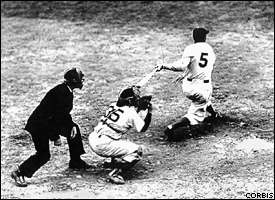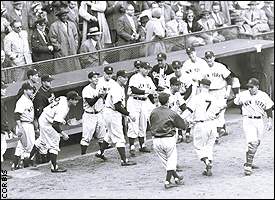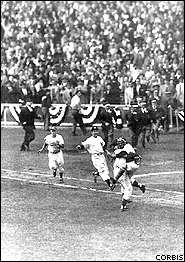|
|
By Larry Schwartz
Special to ESPN Classic
New York baseball teams have collided in a Subway Series on 13 previous occasions. From 1921 - 1956, the Yankees, Giants and Dodgers provided many classic World Series moments. Here are some of the best:
Oct. 10, 1923 -- In the first World Series game ever played at Yankee
Stadium, between the Giants and Yankees, the mighty Casey strides to the
plate with two outs in the top of the ninth inning with Game 1 tied at 4-4.
On a full count, Giants outfielder Casey Stengel smashes a fastball from
Yankees reliever Joe Bush on a line to left-center.
Stengel mutters encouragement to his sore legs even as one shoe
comes unlaced as he rounds second base. Leftfielder Bob Meusel finally
retrieves the ball at the wall and fires to the relay man, whose throw home
skips past catcher Wally Schang as Stengel slides in safely. Stengel bounces
up onto one knee and, as James Harrison of The New York Times writes, "waved
a hand in a comical gesture that seemed to say, 'Well, there you are.' "
The Yankees are retired in the ninth, and Casey's inside-the-park
homer, the first postseason homer at Yankee Stadium, has given the Giants a
5-4 victory.
Oct. 12, 1923: Two days later, Casey Stengel does it again, winning
Game 3 for the Giants with another homer. This time, his seventh-inning
drive off Sam Jones goes into the rightfield bleachers, giving the Giants a
1-0 victory. It is the first postseason homer into the stands at Yankee
Stadium.
Stengel's two home runs provide the Giants with their only victories
of the Series as the Yankees capture their first world championship, winning
in six games.
Oct. 5, 1941: It could only happen in Brooklyn. With a one-run lead going into the ninth inning of Game 4 of the World Series, the Dodgers get three outs - and still lose the game.
|  | | Mickey Owen scrambles to retrieve the infamous missed strike three in Game 4 of the 1941 Series. |
The Yankees' Tommy Henrich swings and misses at Hugh Casey's 3-2 pitch with two outs in the ninth. But instead of the game being over, Henrich reaches first base when catcher Mickey Owen fails to corral the third strike.
"It was a great breaking curve that I should have had," Owen says. "But I guess the ball hit the side of my glove. It got away from me, and by the time I got hold of it, near the corner of the Brooklyn dugout, I couldn't have thrown anybody out at first."
The Yankees take advantage of that excruciating error. Joe DiMaggio follows with a single and Charley Keller rips a two-run double as the Yankees take the lead. After a walk to Bill Dickey, Joe Gordon also raps a two-run double to give the Yankees a 7-4 victory at Ebbets Field.
The win gives the Yankees a 3-1 lead (they will capture the Series the next day) and Mickey Owen an unwanted place in history.
Oct. 3, 1947: New York Yankees righthander Bill Bevens is one out from pitching the first no-hitter in World Series history. |  | | Pinch-hitter Cookie Lavagetto breaks up Bill Bevens' no-hitter with two outs in the ninth. |
But Brooklyn Dodgers pinch-hitter Cookie Lavagetto spoils not only Bevens' bid for immortality, but also for victory.
Trailing 2-1 with two outs in the ninth, and with Dodgers on first and second via walks, Dodgers manager Burt Shotton sends up Lavagetto to bat for leadoff hitter Eddie Stanky, only the second time all year Stanky is replaced by a pinch-hitter.
Lavagetto raps Bevens' second pitch over Tommy Henrich's head and off the rightfield wall in Ebbets Field. The double scores two pinch-runners and gives the Dodgers a 3-2 victory and ties the Series at two games apiece.
While Bevens doesn't get into the record books as the first to throw a Series no-hitter he gets into it another way today: His 10 walks are a Series record.
Oct. 5, 1947: Little leftfielder Al Gionfriddo is the big man for Brooklyn when he robs one of the game's giants, Joe DiMaggio, of a game-tying three-run homer in Game 6 of the World Series.
Having scored four runs in the sixth to take an 8-5 lead, Dodgers manager Burt Shotton inserts Gionfriddo for defense in the bottom of the inning at Yankee Stadium. With two Yankees on base and two outs, DiMaggio clocks a pitch from lefty Joe Hatten.
Gionfriddo races back and a step or so short of the visitors' bullpen, leaps and makes a spectacular catch of the 415-foot drive in front of the low railing. "The ball hit my glove and a split second later I hit the gate," says Gionfriddo. "It certainly would have gone into the bullpen alley for a home run if I hadn't got it."
As DiMaggio approaches second base, he kicks the dirt in disgust, one of the rare times the Yankee Clipper shows emotion on the diamond.
The Dodgers go on to post an 8-6 victory, tying the Series at three games each. It is the last game Gionfriddo will ever play in the majors. The next day, the Yankees will win 5-2 to take the Series.
Oct. 7, 1952: Mickey Mantle homers in the sixth inning of Game 7 to
break a tie and the Yankees score another run in the seventh to extend their
lead to 4-2 over Brooklyn.
In the bottom of the inning, the Dodgers have the bases loaded with
two outs. |  | | Mantle is congratulated by his teammates after his Game 7 homer. |
It seems as if reliever Bob Kuzava is out of trouble when he
induces Jackie Robinson to pop up near the mound. But Kuzava and first
baseman Joe Collins either lose the ball or freeze.
Out of nowhere comes second baseman Billy Martin. Cap flying, he
dashes in and catches the ball just before it is about to hit the ground.
Billy the Kid's robbery prevents the Dodgers from tying the game.
Kuzava, in his only appearance of the Series, blanks the Dodgers in the last
two innings as the Yankees win 4-2 for their fourth consecutive world
championship.
Oct. 2, 1953: Brooklyn Dodgers righthander Carl Erskine, who lasted
just one inning in the World Series opener two days earlier, sets a Series
record by fanning 14 New York Yankees -- including Mickey Mantle and Joe
Collins four times each -- in Game 3 at Ebbets Field.
Catcher Roy Campanella helps his battery mate out offensively when
he homers in the bottom of the eighth inning to break a 2-2 tie. Erskine
pitches a scoreless ninth to win 3-2.
Oct. 5, 1953: Down three games to two and trailing by two runs
entering the top of the ninth inning of Game 6, the Brooklyn Dodgers tie the
game on Carl Furillo's two-run homer off Allie Reynolds in Yankee Stadium.
But their joy is short-lived. In the bottom of the inning, Billy
Martin singles home the winning run off Clem Labine to give the Yankees a
4-3 victory and their record fifth consecutive world championship. It is a
record 12th hit of the Series for Martin, known more for pummeling people
than pitchers.
Oct. 4, 1955: Finally, it's next year for the Brooklyn Dodgers. Losers of their previous seven World Series, the Bums are celebrating in the penthouse after winning their first world championship.
|  | | Johnny Podres is mobbed by his Dodger teammates after clinching the '55 Series. |
Losers of five Series to the Yankees since 1941, the Dodgers win today's seventh game 2-0 behind the eight-hit pitching of lefthander Johnny Podres and a spectacular catch by leftfielder Sandy Amoros.
The 23-year-old Podres, who was 9-10 during the season, is the first Brooklyn pitcher to ever win two games in the same Series. He pitched a complete game in beating the Yankees 7-3 in Game 3.
"Hey, Pee Wee," Podres shouts across the jubiliant locker room to shortstop Pee Wee Reese. "What did I tell you? I said they wouldn't get a thing off me, didn't I?"
With a hand from Amoros, the Yankees don't. The Dodgers have a 2-0 lead in the sixth inning (courtesy of Gil Hodges' run-scoring single and sac fly) when left-handed hitter Yogi Berra slices a drive deep down the leftfield line with Yankees on first and second. Amoros, who had come into the game that inning in a double switch, races across the field and at the last second sticks out his right (glove) hand and makes the catch. Then he fires to Reese, whose throw to first doubles off Gil McDougald.
Three innings later, it's catcher Roy Campanella picking up Podres after the final out. No longer is it wait 'til next year in Brooklyn.
Oct. 8, 1956: Two years ago, Don Larsen had a 3-21 record with Baltimore. Today, he's the toast of the baseball world. The imperfect man pitches a perfect game - in the World Series. The New York Yankees righthander, known more for his partying than pitching, hurls the only perfect game (and only no-hitter as well) in Series history in beating the Brooklyn Dodgers 2-0.
|  | | With the no-hitter completed, Yogi Berra leaps into Don Larsen's arms. |
Three days after blowing a 6-0 lead in Game 2, the no-windup pitcher winds up his classic performance in Game 5 by slipping a called third strike to pinch-hitter Dale Mitchell before 64,519 breathless fans at Yankee Stadium.
Larsen, who came to the Yankees in an 18-player trade, is helped by three outstanding fielding plays. In the second inning, Jackie Robinson's hard grounder goes off third baseman Andy Carey's glove. But shortstop Gil McDougald recovers the ball in time to throw out Robinson.
In the fifth, centerfielder Mickey Mantle, whose homer had given the Yankees a 1-0 lead, streaks into deep left-center to make a backhanded catch and rob Gil Hodges of an extra-base hit. In the eighth, it's Carey's turn to rob Hodges, as he lunges to catch Hodges' liner inches off the ground.
Oct. 10, 1956: In the last Subway Series of the 20th century, the
Yankees come out on top again when they crush the Dodgers 9-0 in Game 7
behind four home runs and the three-hit pitching of righthander Johnny
Kucks.
Against Cy Young Award winner Don Newcombe, Yogi Berra slugs two-run
homers in the first and third innings and Elston Howard hits a solo shot in
the fourth. Bill Skorown wraps up the scoring with a grand slam in the
seventh.

Copyright ©2000 ESPN Internet Ventures. Terms of Use and Privacy Policy and Safety Information are applicable to this site. Click here for a list of employment opportunities at ESPN.com.
|
|
|
|
|




